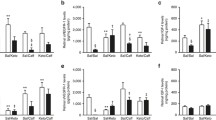Abstract
Background
Systemic acidosis induces preretinal neovascularization (NV) analogous to retinopathy of prematurity (ROP) in the neonatal rat. Sodium bicarbonate is used in human neonates to treat acidosis. The effects of alkali administration on the developing retinal vasculature and on acidosis-induced retinopathy (AIR) are unknown. We investigated the effect of sodium bicarbonate gavage on the retinal vasculature of normal and acidotic neonatal rats to determine (1) whether bicarbonate treatment is associated with preretinal NV and (2) whether AIR can be prevented with systemic bicarbonate treatment.
Methods
The extent of acidosis and alkalosis were initially determined from carotid arterial blood samples. In the bicarbonate-alone study, newborn rats were randomized into litters of 25 and received bicarbonate doses of 15 mmol/kg twice daily and 20 mmol/kg once daily from days 2 to 7. Control animals received saline gavage. In the AIR treatment study, acidosis was induced in neonatal rats by intraperitoneal injection of acetazolamide 200 mg/kg from days 2 to 7. Acetazolamide-treated rats received either additional bicarbonate gavage or no additional treatment. Eyes were enucleated on day 13, and the retinal vasculature was assessed for NV using ADPase staining techniques and light microscopy.
Results
Systemic alkalosis (peak pH 7.55±0.02; mean ± SD) was confirmed with bicarbonate gavage, and partial reversal of acidosis was confirmed when acetazolamide-treated rats received bicarbonate. Surviving rats receiving bicarbonate 15 mmol/kg twice daily (28% survival) and 20 mmol/kg bicarbonate once daily (45% survival) had an incidence of preretinal NV of 9% and 8%, respectively. No NV was seen in saline-control rats. In the acetazolamide-treated rats, the incidence of preretinal NV in surviving rats was numerically lower in bicarbonate-treated rats than acetazolamide-only controls (8% versus 24%, p=0.065) but with only 19% survival in the bicarbonate-treated rats.
Conclusions
In the neonatal rat, alkalosis induced by bicarbonate gavage is associated with a low incidence of mild, preretinal NV similar to ROP. Although treating acidotic rats with bicarbonate may reduce the incidence of preretinal NV, treatment was associated with an unacceptable mortality rate.



Similar content being viewed by others
References
Ammari AN, Schulze KF (2002) Uses and abuses of sodium bicarbonate in the neonatal intensive care unit. Curr Opin Pediatr 14:151–156
Bassiouny MR (1996) Risk factors associated with retinopathy of prematurity: a study from Oman. J Trop Pediatr 42:355–358
Berkowitz BA, Zhang W (2000) Significant reduction of the panretinal oxygenation response after 28% supplemental oxygen recovery in experimental ROP. Invest Ophthalmol Vis Sci 41:1925–1931
Biglan AW, Brown DF, Reynolds JD, Milley JR (1984) Risk factors associated with retrolental fibroplasia. Ophthalmology 91:1504–1511
Holmes JM, Duffner LA (1995) The effect of litter size on normal retinal vascular development in the neonatal rat. Curr Eye Res 14:737–740
Holmes JM, Duffner LA (1996) The effect of postnatal growth retardation on abnormal neovascularization in the oxygen exposed neonatal rat. Curr Eye Res 15:403–409
Holmes JM, Zhang S, Leske DA, Lanier WL (1997) The effect of carbon dioxide on oxygen-induced retinopathy in the neonatal rat. Curr Eye Res 16:725–732
Holmes JM, Zhang S, Leske DA, Lanier WL (1998) Carbon dioxide-induced retinopathy in the neonatal rat. Curr Eye Res 17:608–616
Holmes JM, Zhang S, Leske DA, Lanier WL (1999) Metabolic acidosis-induced retinopathy in the neonatal rat. Invest Ophthalmol Vis Sci 40:804–809
Koerner F, Bossi E, Wetzel C, Flury B (1986) Retinopathy of prematurity; the influence of gestational age and retinal maturity on the statistical behaviour of risk factors. Graefes Arch Clin Exp Ophthalmol 224:40–45
Lutty GA, McLeod DS (1992) A new technique for visualization of the human retinal vasculature. Arch Ophthalmol 110:267–276
Ostrea EM Jr, Odell GB (1972) The influence of bicarbonate administration on blood pH in a “closed system”: clinical implications. J Pediatr 80:671–680
Penn JS, Tolman BL, Lowery LA (1993) Variable oxygen exposure causes preretinal neovascularization in the newborn rat. Invest Ophthalmol Vis Sci 34:576–585
Prenderville A, Suchulenburg WE (1988) Clinical factors associated with retinopathy of prematurity. Arch Dis Child 63:522–527
Reynaud X, Dorey CK (1994) Extraretinal neovascularization induced by hypoxic episodes in the neonatal rat. Invest Ophthalmol Vis Sci 35:3169–3177
Turbeville DF, Bowen FW Jr, Killam AP (1976) Intracranial hemorrhages in kittens: hypernatremia versus hypoxia. J Pediatr 89:294–297
Young RS, Yagel SK, Woods CL (1984) The effects of sodium bicarbonate on brain blood flow, brain water content, and blood–brain barrier in the neonatal dog. Acta Neuropathol (Berl) 65:124–127
Zhang S, Leske DA, Lanier WL, Berkowitz BA, Holmes JM (2001) Preretinal neovascularization associated with acetazolamide-induced systemic acidosis in the neonatal rat. Invest Ophthalmol Vis Sci 42:1066–1071
Zhang S, Leske DA, Holmes JM (2000) Neovascularization grading methods in a rat model of retinopathy of prematurity. Invest Ophthalmol Vis Sci 41:887–891
Acknowledgments
Supported by National Institutes of Health Grant EY12798 (JMH), Research to Prevent Blindness, Inc., New York, (JMH as RPB Olga Keith Weiss Scholar and an unrestricted grant to the Department of Ophthalmology, Mayo Clinic), Mayo Foundation, Rochester, Minnesota, and the philanthropy of Margaret Schroeder (JMH).
Author information
Authors and Affiliations
Corresponding author
Rights and permissions
About this article
Cite this article
Berdahl, J.P., Leske, D.A., Fautsch, M.P. et al. Effect of bicarbonate on retinal vasculature and acidosis-induced retinopathy in the neonatal rat. Graefe's Arch Clin Exp Ophthalmol 243, 367–373 (2005). https://doi.org/10.1007/s00417-004-0997-5
Received:
Revised:
Accepted:
Published:
Issue Date:
DOI: https://doi.org/10.1007/s00417-004-0997-5




